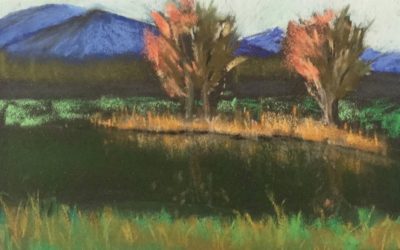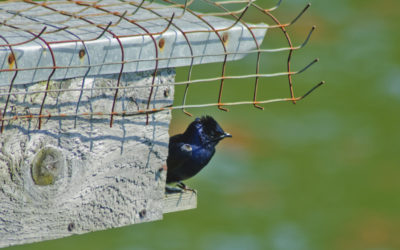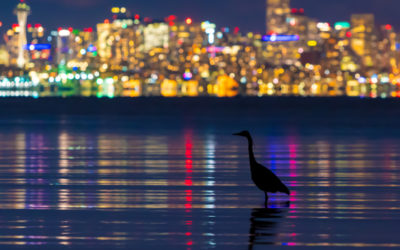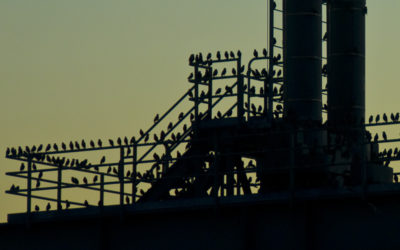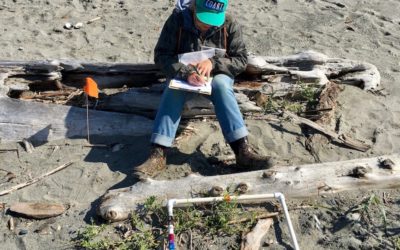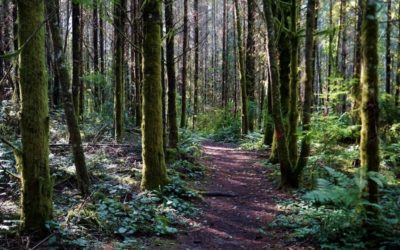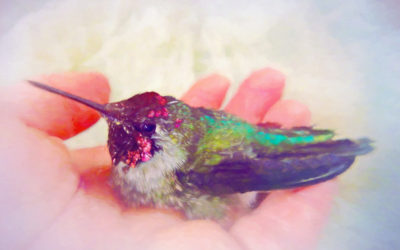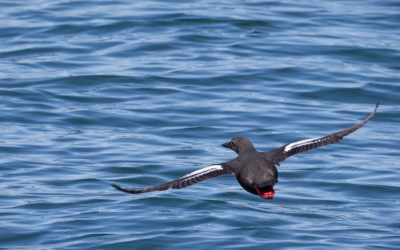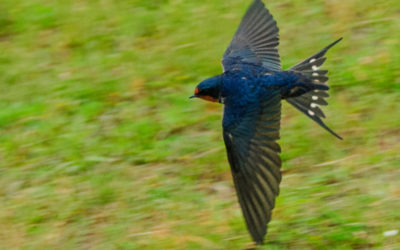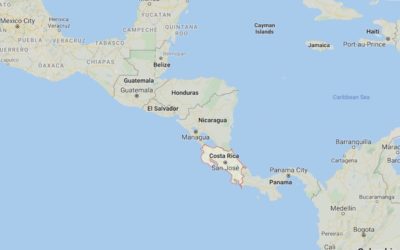THE RUSSIANS ARE COMING!
by Paul Pegany, Winter 2019
Photo by Catherine Whalen
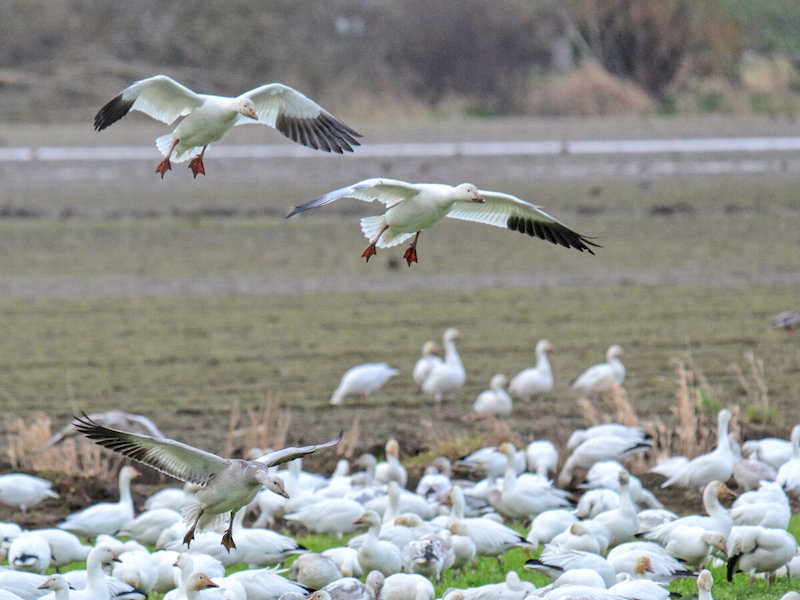
Photo by Catherine Whalen
THE RUSSIANS ARE COMING!
by Paul Pegany, Winter 2019
The Russians are indeed coming! They are winged, white, and ready to spend their winter along the shores of the Salish Sea in northwest Washington. As the rain and chill of the season settles in, it also heralds the time for the annual migration of Snow Geese from Russia’s Wrangel Island to one of their favorite winter hangouts—our own Skagit Valley.
To help us better appreciate these birds, a bit of background on the summer breeding grounds of Washington’s winter “Russian Refugees” is in order.
wrangel island
Wrangel Island is located in the Arctic Ocean off the coast of Siberia. Until the late 1800s, its remote location, coupled with its fog and ice-shrouded landforms, cloaked the island in mystery. For years, many speculated as to its very existence. John Muir, who was among the early travelers to this land in 1881, described it as a “grand wilderness in its untouched freshness,” a “severely solitary land” in the “topmost, frost-killed end of creation.”
 See FIND OUT MORE at the end of this article for more about this John Muir quote.
See FIND OUT MORE at the end of this article for more about this John Muir quote.
Once discovered, American, Canadian, and Russian governments vied for ownership of the island. In a 1926 effort to promote sovereignty, the Russian government (then the Soviet Union) went so far as to force the relocation of indigenous people from the nearby Chuckchi Peninsula to a settlement on Wrangel Island.
Fifty years later, in 1976, the Soviet government closed the settlement and declared the entire island a nature preserve, later adding 24 nautical miles of surrounding Arctic Sea. Ironically, those same Chuckchi families who were forcefully moved to Wrangel Island in the 1920’s were ordered to abandon their village on the island and return to their indigenous land.
Fast forward to today: Currently, there are four year-round island residents—rangers who inhabit some of the buildings that remain from the previous Soviet settlement. During the summer, the population swells by about 12, as the Russian government allows teams of scientists to study the animal and plant life. High temperatures during this time average a “balmy” 42 degrees. Winter temperatures seldom get above zero degrees Fahrenheit.
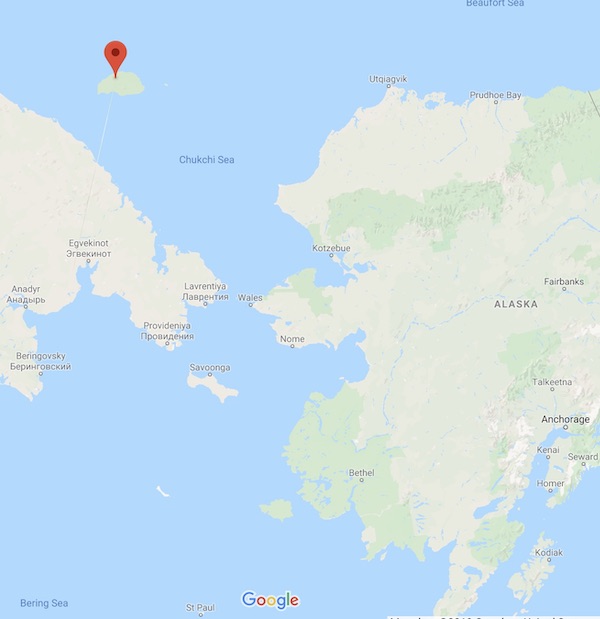
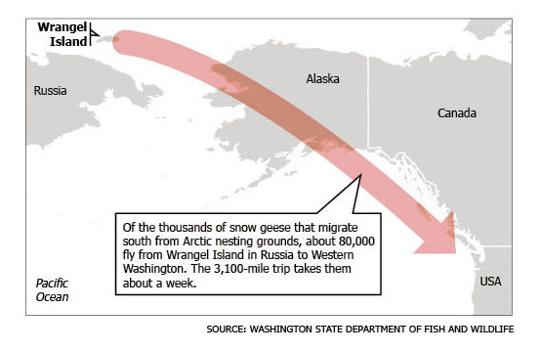
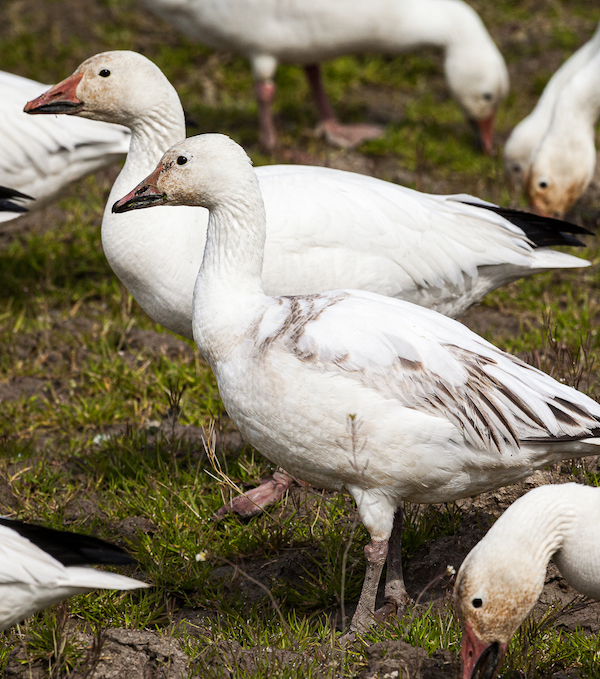
Photo by Lee Tenneboe
The cold ocean waters surrounding the reserve host beluga, gray, and bowhead whales that are often spotted from shore. Remarkably, this 2,900 square-mile island contains the highest density of polar bear dens in the world, making it a fertile breeding ground for these iconic Arctic mammals.
As bleak as the Wrangel environment might sound to those of us used to the relatively mild winters of the Salish Sea region, Wrangel Island’s short summer months are a haven for migratory birds. In fact, the island reserve is the northernmost breeding ground for over 100 species of birds. The most notable and visible of these birds are our migrating “Russian Refugees,” snow geese.
Wrangel Island snow geese are the last major snow goose population breeding in Asia. During their summers on Wrangel Island, they breed and raise their young. The open tundra, consisting of moss and lichen, provides ideal habitat for these birds to breed, feed, and prepare for the 3,000 mile migration to the Washington’s Skagit Valley and British Columbia’s Fraser River valley, as well as favorite wintering spots as far south as the central valley of California.
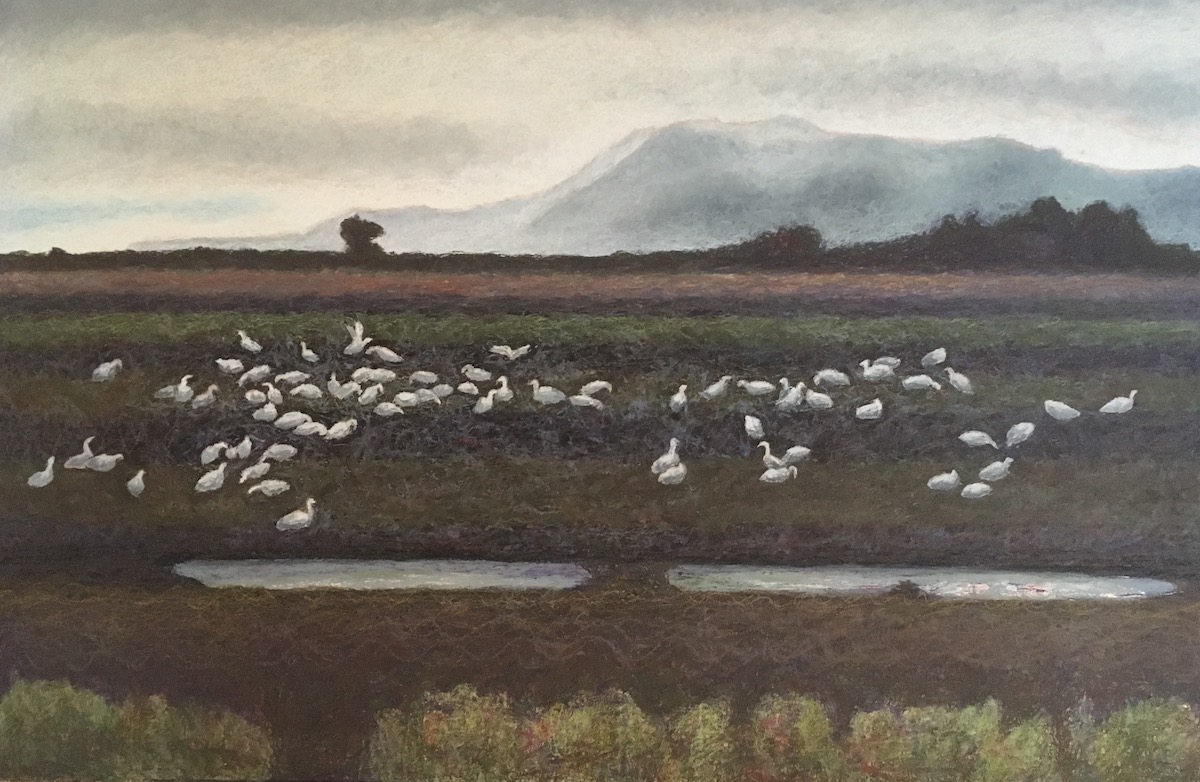
Oil pastel by Kathleen Faulkner
the price of success
Wrangel Island snow geese are truly one of the incredible success stories of avian recovery. As late as the mid-1970s, Wrangel Island’s snow goose population was reduced to about 50,000 birds. Today, there are an estimated 300,000 geese that annually return to Wrangel Island.
In fact, they might be a little bit too successful. Washington’s wintering snow geese naturally feed on salt marsh plants of the Skagit River delta, particularly three-square bulrush. As the snow goose population continues to increase, native delta tidelands can no longer support the sheer quantity of birds. Hence, the geese have turned to local farm fields to supplement their winter diet.
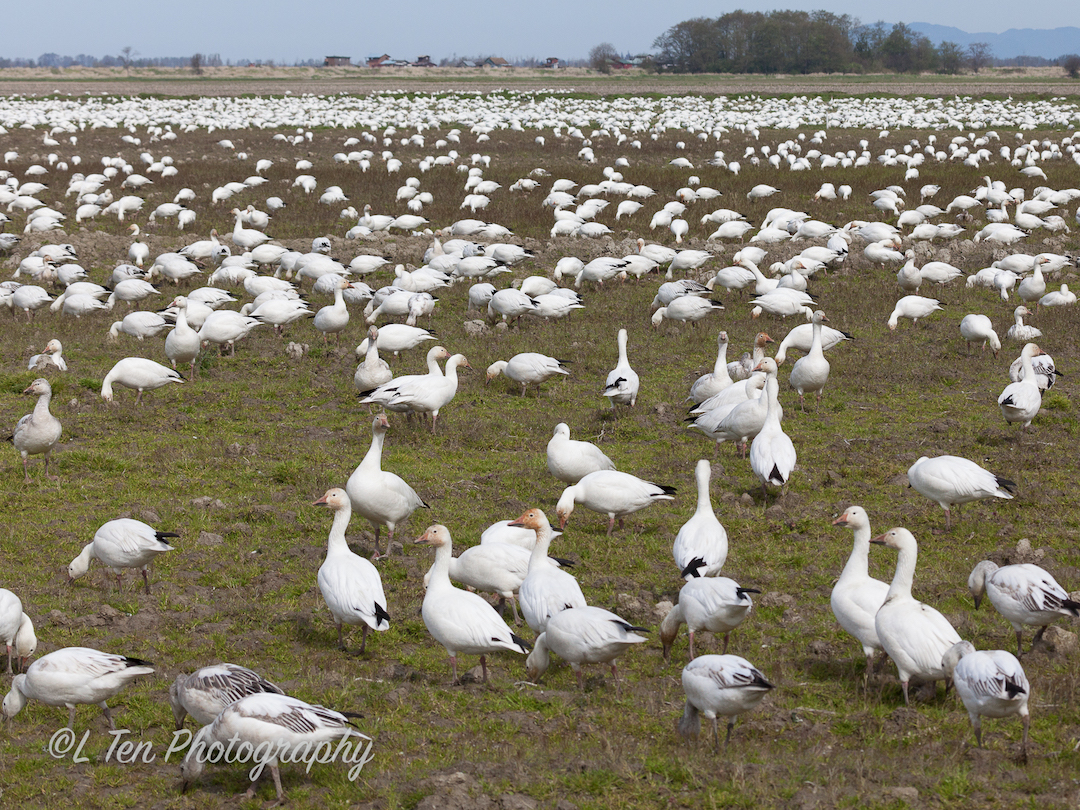
Photo by Lee Tenneboe
Compounding the problems of an increasing population and limited food supply, snow geese have a tendency to rip their food out of the ground, root and all. This demolishes their habitat relatively quickly. As a result, some wildlife managers consider their current numbers unsustainable. The quantity and feeding habits of these birds are particularly damaging to the fragile tundra of Wrangel Island. Here in the Salish region, snow geese can decimate a farmer’s winter cover crop in short order.
Photos by Catherine Whalen
Part of their success in the Skagit Valley is due to the fact that there are relatively few predators for these birds as they dine in the farm fields. Bald eagles and other raptors are their greatest natural predators, but they tend to capture ill or lame birds. One swoop of a raptor sends a dizzying cloud of snow geese into the air, leaving only the ill-equipped behind. Coyotes and other mammals provide a second layer of predation.
Their biggest threat comes from human hunters. In the early part of the 20th century, worldwide population of snow geese was down to an estimated few thousand birds due to over-hunting. In fact, limits placed on hunting during the 1900’s is a crucial factor in what has given the snow goose its amazing rise in numbers, which in turn has altered the natural balance of birds, food sources, and predators.
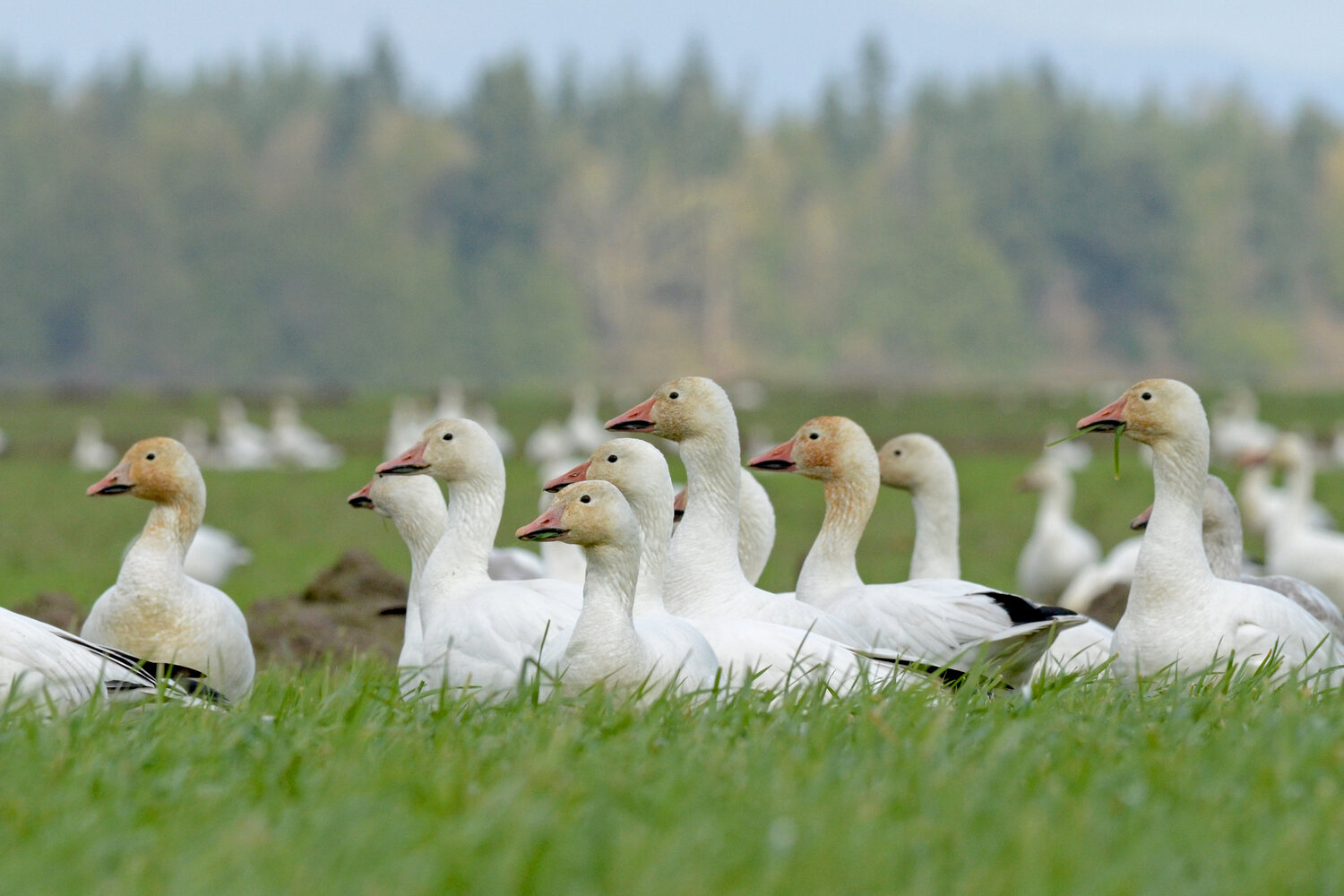
Photo by Catherine Whalen
seeking solutions
The conundrum facing wildlife managers today is how to juggle the competing interests of predators, farmers, and the need to provide a safe haven and healthy diet for the tens of thousands of geese that arrive annually. One of these efforts is the Skagit Wildlife Area managed by the Washington Department of Fish and Wildlife. The Wildlife Area is located on Fir Island, which is framed by the north and south forks of the Skagit River between Conway and La Connor.
The Wiley Slough unit of the Wildlife Area provides 190 acres of tidal marsh habitat which is frequented by waterfowl, as well as their natural predators. This area is open to hunting and is popular with hunters during the winter months.
An additional 225 acres of the Wildlife Area is set aside as the Fir Island Farm Reserve. This no-hunting unit of the reserve was created in 1995 and utilizes a unique approach to supporting snow goose populations.
Under a lease agreement, a local farmer agrees to plant an over-winter crop of wheat after selling their own cash crop. The wheat is specifically grown for snow goose forage. This farmer also plants an additional 295 acres of wheat on an adjoining property. This allows the farmer to harvest a cash crop during the farming season, as well as providing intentional feeding grounds for the snow geese population.
Apparently, word is out among the snow geese cognoscenti about the mild winters and good eats to be found in the Skagit Valley. In the 1960s, it was estimated that 80-90% of Wrangel Island snow geese made a stop-over in the region, but then continued further south to California’s Central Valley. Only 10-20% remained in the Skagit.
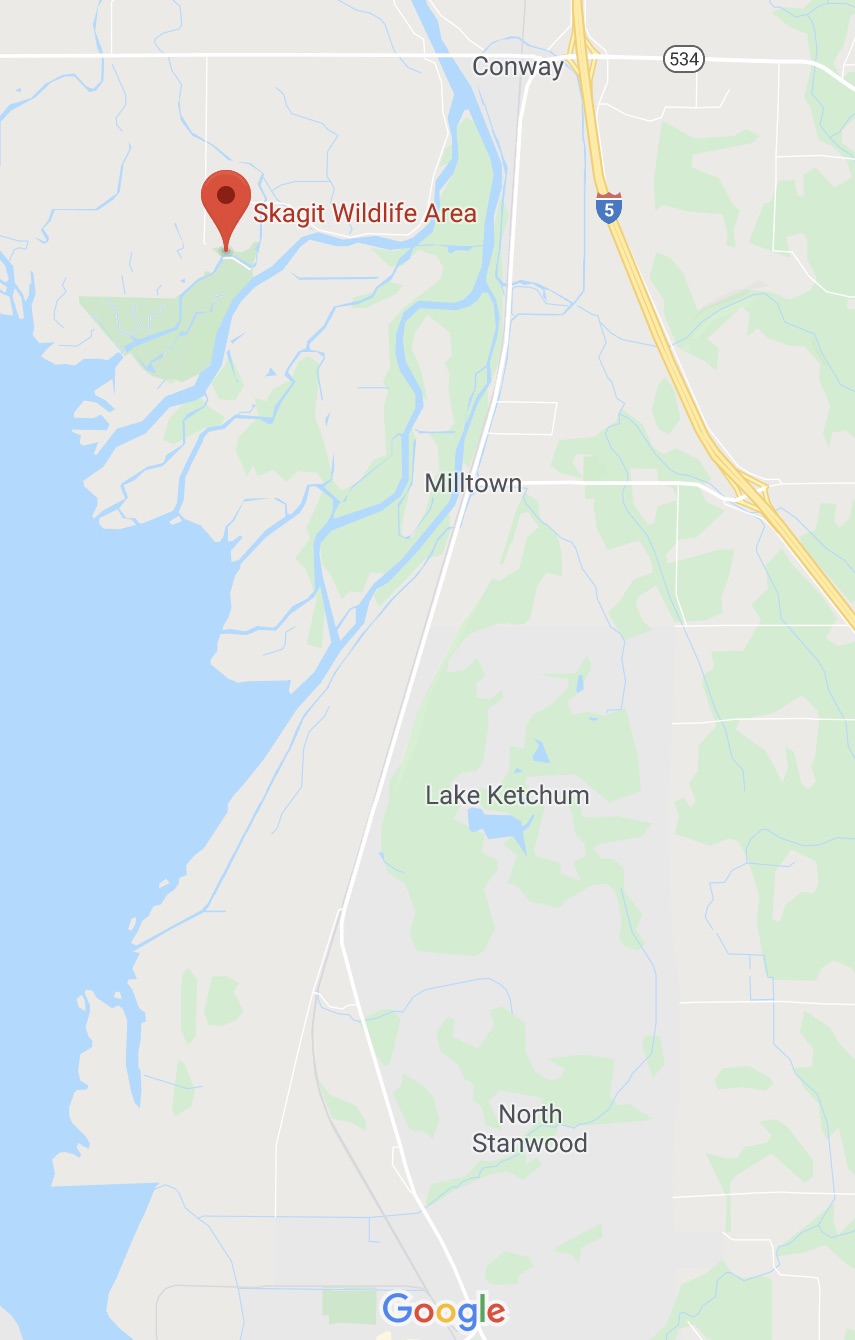
Photos by Catherine Whalen
Today, in a remarkable turn of events, the majority of these birds have abandoned their California winter haunts. Over 60% of Wrangel Island snow geese now remain in the Salish Sea region for their entire winter season, with less than 40% continuing their journey south to California. While their increase in numbers puts further pressure on their food sources, it also provides ample opportunity to view these birds throughout the river valleys of western Washington and the lower mainland of British Columbia.
Snow geese enjoy our relatively mild Salish winters from early November through April. In addition to their traditional winter feeding grounds in northwest Washington and southwest British Columbia, they can be found in delta and farmland throughout the Salish Sea region.
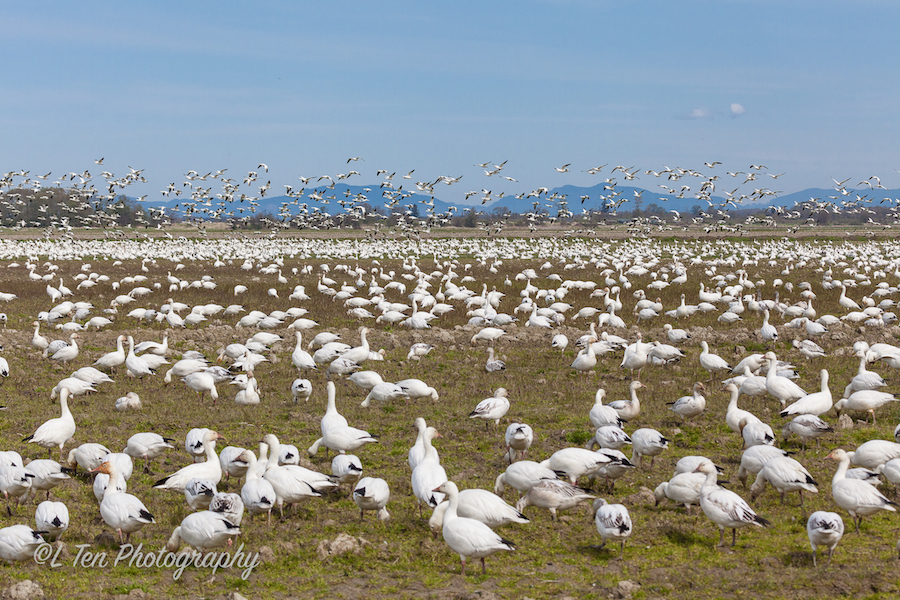
Photo by Lee Tenneboe
opportunities for exploration
Despite the sometimes daunting management challenges, viewing these birds on the loamy farmland of “The Skagit” still stirs wonder in me. As they tend to congregate in groups, it is easy to spot a mass of white among the green or fallow fields. Often times, a sudden scare will lift a huge cloud of white from the farm fields into the sky. The relatively lightly-traveled roadways of the valley provide an easy view of these inter-continental visitors.
If you tour the Skagit with your car windows down or as part of a cycle tour, your first encounter will more than likely be auditory versus visual, as snow geese are among the noisiest of all waterfowl. Their nasal honks create a cacophony that can be heard at a great distance and they will erupt in chorus anytime day or night.
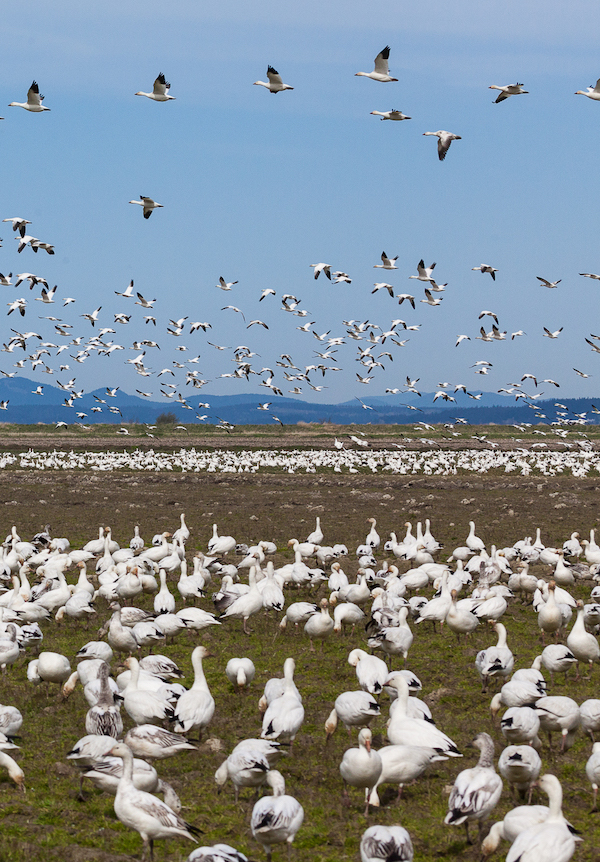
Photo by Lee Tenneboe
Perhaps you would like to learn more about snow geese, but don’t exactly relish the thought of sloshing around the Skagit Valley in February. The Port Susan Snow Goose Festival is just for you! This annual event will be held February 22-23, 2020 in the Stanwood and Camano Island communities.
This event features classes and photography workshops on snow geese and other wintering birds of the Stanwood/Camano area, as well as multiple bus and walking tours to see the birds and unique ecosystems of this area. Events are free to the public, but tours require sign-up. Check the website: discoverstanwoodcamano.com for more information as the festival draws nearer.
Whether attending the Port Susan festival, visiting the Skagit Wildlife Area, or simply driving through the farmlands of the Skagit Valley, take time this winter to marvel at the tenacity of these “Russian Refugees” as they make their annual pilgrimage to our Salish shores.

Painting by Catherine Whalen
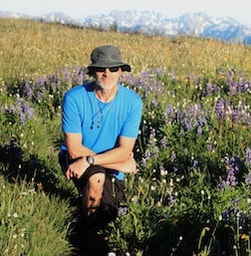
Paul Pegany is a retired elementary educator who has over 30 years of experience in helping students better understand the world around them through science and literature. He splits his time between the Sonoran Desert of Arizona and the forests and seas of the Pacific Northwest. His goal is to help people of all ages better appreciate the beauty of the world, as well as understand the stewardship role that humans play as part of the greater ecosystem. Along with his wife, Sharon, he works to build his own knowledge through coursework and experiences in whichever biome he finds himself.
Table of Contents, Issue #6, Winter 2019
Birds of Bufflehead Pond
by Adelia Ritchie, Winter 2019Painting by Adelia Ritchieby Adelia Ritchie, Winter 2019 Such big ideas we had when we first set out to inhabit Bufflehead Pond Farm! The place had not been properly tended for years and the local ecology (mostly blackberries and...
Purple Martins
by Gene Bullock, Winter 2019Photo by John F. WilliamsPhoto by John F. Williamsby Gene Bullock, Winter 2019 Native Americans learned long ago that if they hung hollow gourds around their villages, they could attract Martins to nest in them. The birds repaid them by...
Great Blue Heron
by Nancy Sefton, Winter 2019Photo by Philip HutchersonPhoto by Philip Hutchersonby Nancy Sefton, Winter 2019 As I floated in my kayak, I spotted a great blue heron perched on a mass of partially submerged roots. Suddenly it stabbed the water and came up with a small...
Poems-6
Winter 2019Winter 2019 Haiku by Nancy Rekow One heron standing.Mist hangs low in the valley.I will write to you.Painting by Kathleen Faulknerby Nancy TaylorIn Beacon Hill Park, Victoria B.C. I watch a bald eaglelight...
Citizen Science
by Todd Ramsey, Winter 2019Photo by Eric Wagner, COASST staffPhoto by Eric Wagner, COASST staffby Todd Ramsey, Winter 2019 It all started out so innocently. We just wanted to pick up trash on the beach after a storm. Soon after that we discovered COASST.org (Coastal...
Foto Tour 2
Showcase of Participant Photos North Kitsap Heritage Park from September 18, 2019 Showcase of Participant Photos North Kitsap Heritage Park from September 18, 2019 On September 18, 2019, WSU Extension in Kitsap County hosted a Forest Foto Expedition led by John F....
Should I Stay?
by Sharon Pegany, Winter 2019Artwork by Catherine WhalenArtwork by Catherine Whalenby Sharon Pegany, Winter 2019 turn of time rustle of feather echoing songs of beak and bill listen afresh to the voices among usWinter may be a quiet season in the Salish Sea region,...
Seabirds Are Cool
by Julia Parrish, Winter 2019Photo by Lee TenneboePhoto by Lee Tenneboeby Julia Parrish, Winter 2019 In Washington State, there is a bewildering abundance of seabirds. The seabirds of the surf zone that always capture my imagination are in the Alcid family: murres,...
Barn Swallow
Nature's Pest Control by Adelia Ritchie, Winter 2019 Photos by John F. Williams except where notedNature's Pest Control by Adelia Ritchie, Winter 2019 Photos by John F. Williams except where notedClose cousin of the purple martin is our hard-working summertime...
Editorial-6
by Adelia Ritchie, Winter 2019by Adelia Ritchie, Winter 2019 On vacation in Costa Rica recently, I walked the city of San José one morning and visited a famous museum of pre-Colombian civilization, back when indigenous tribes lived in harmony with nature and as a...
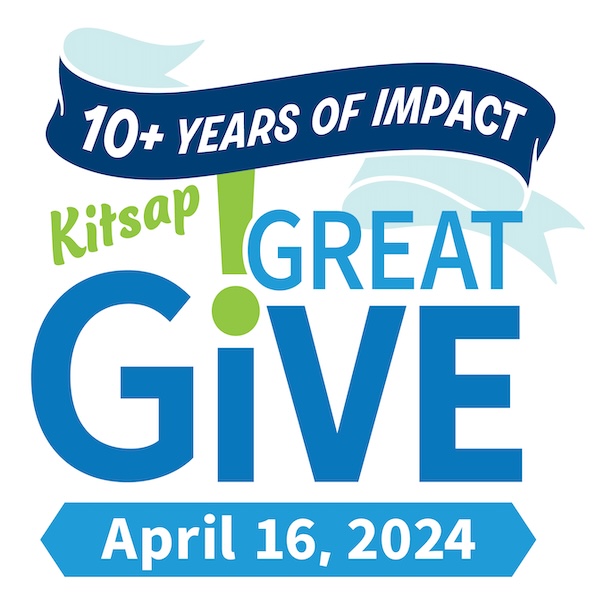
PLEASE HELP SUPPORT
SALISH MAGAZINE
Salish Magazine contains no advertising and is free. Your donations is one big way you can help us inspire people with stories about things that they can see outdoors in our Salish Sea region.
DONATE via the Kitsap Great Give!
The Kitsap Great Give main 24-hour online giving event is April 16th, but you can donate today!
We also don't advertise Salish Magazine, so please spread the word of this online resource to your friends and colleagues.
Thanks so much for your interest and your support.
FIND OUT MORE
John Muir quote: The Luck of the Karluk: Shipwrecked in the Arctic, L.D. Cross. On a three-year mission to chart unexplored landmasses in the Western Arctic, the ship was caught in ice and sank, leaving a group of castaways to make their way to solid ground on desolate Wrangel Island.
Bird Web by Seattle Audubon Society
Birds of Winter: A Skagit Valley Experience
Snow Goose by National Geographic
Snow Goose by Wikipedia
Snow Goose Festival Camano Island
Russian Refuge: Wrangel Island by National Geographic
Washington’s Winter Birds by The Nature Conservancy
Wrangel Island by Wikipedia

